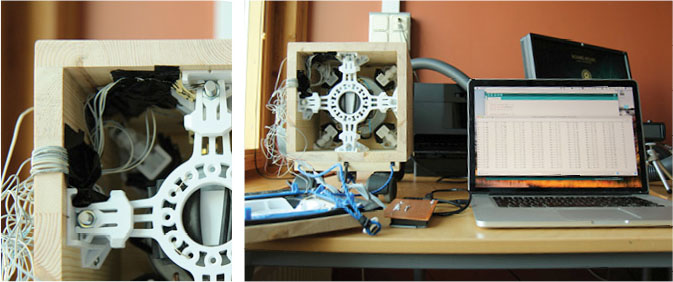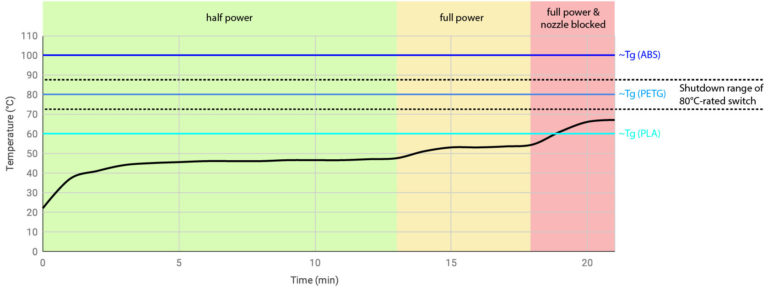
After verifying that the first prototype works better than expected, I decided to run a ‘meltdown-test‘ by letting the vacuum cleaner run with half and full power with the floor-head on the ground. Later I even blocked the hose to see how soon the motor compartment would reach high temperatures with a 1400W motor in a room at ~22°C. I mounted seven temperature sensors in several spots of the motor compartment and one near the heatsink of the dimmer, closed the vacuum cleaner tight and tracked the temperature live with the help of an Arduino.
The result was that temperature rises relatively evenly in the motor chamber (Δ=5°C) and does not reach critical temperatures easily. The best (warmest) spot to mount a heat switch that cuts power above 80°C are the upper corners facing the bag chamber – presumably because they‘re not in the air flow. Thanks to active cooling the electronics compartment only heated up by 2.5°C.

After about 3 minutes running with half power the temperature stayed quite constant at ~45°C and heated up to only 47°C in the next 10 minutes so I decided to run the motor at full power, which increased the temperature to 53°C within 2 minutes. I ran it for 3 more minutes with no significant temperature change and then blocked the hose, which made the temperature climb to to 67°C. The temperature seemed to settle there and I wanted to let it run a bit longer, but had to stop the test because the air outlet grid bulged outwards. It was made from PLA and started to melt because the glass transition temperature (Tg) of PLA had been exceeded.
Before the test I planned to use PETG for the parts in the motor chamber and to install a heat switch that shuts down at 70°C. PETGs Tg lies around 80°C. Using this setup might however mean that the vacuum cleaner turns off rather soon with a semi-full bag on a warm day, because a 70°C-rated switch opens somewhere between 62°C and 78°C. So in this scenario the vacuum cleaner might either scrape the glass temperature or turn off frequently. Finally I decided to use ABS for parts that are exposed to heat. This allows using a 80°C-rated heat-switch, but ABS is unfortunately not yet very fun to print on household-desktop-3D-printers.
